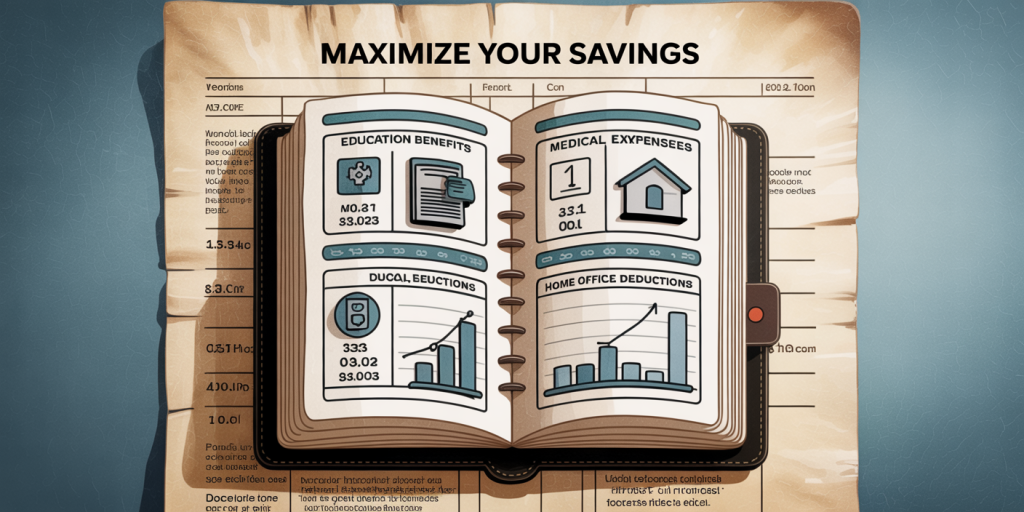Navigating the complexities of the tax code is a challenge faced by millions each year. While most taxpayers strive to claim deductions and credits to minimize their tax liabilities, many overlook certain opportunities that could significantly reduce their owed amount or increase their refund. With tax laws constantly evolving and new provisions appearing frequently, it’s crucial to be aware of lesser-known tax deductions and credits that are often missed.
Understanding these hidden opportunities not only helps businesses and individuals retain more of their hard-earned money but also promotes more accurate tax filing. As tax season approaches, this comprehensive guide aims to highlight some of the most commonly overlooked tax breaks, supported by practical examples and comparative data, enabling taxpayers to optimize their returns legally and efficiently.
Education-Related Tax Benefits Often Overlooked
Education expenses represent one of the significant categories where many taxpayers miss critical tax credits and deductions. While many are familiar with tuition deductions or grants, other potential benefits like the Lifetime Learning Credit and student loan interest deductions are frequently underutilized.

The Lifetime Learning Credit (LLC) offers up to $2,000 per tax return for qualified education expenses, applicable not only to degree programs but also to courses aimed at acquiring or improving job skills. Unlike the American Opportunity Credit, which is limited to four years of post-secondary education, the LLC can be claimed indefinitely. For example, Jane, a working professional who took several certification courses in project management last year, was unaware that these expenses qualified for the LLC. By reviewing her eligibility, she was able to reduce her tax liability by $2,000, a significant savings compared to ignoring this credit.
Likewise, the student loan interest deduction, which allows taxpayers to deduct up to $2,500 in interest payments annually, is frequently missed by filers who fail to report or claim it. According to the Federal Student Aid Office, nearly 45 million Americans carry student debt, yet many do not take advantage of this deduction, losing out on thousands of potential tax savings.
Medical Expenses: A Goldmine for Savvy Taxpayers
Medical expenses are another area rife with opportunities that many taxpayers overlook, partly due to confusing qualification thresholds. The IRS allows the deduction of unreimbursed medical expenses exceeding 7.5% of adjusted gross income (AGI) for tax years 2023 onward. This threshold makes the deduction seemingly inaccessible for many, but strategic planning and thorough documentation can unlock significant benefits.
For example, Michael, a taxpayer with an AGI of $50,000, must exceed $3,750 in medical expenses to claim any deduction. By itemizing costs such as prescription medications, dental procedures, and transportation for medical care, Michael realized he narrowly exceeded this limit with a total of $5,000 in expenses. Claiming this deduction saved him approximately $325 in taxes, an amount he would have missed if opting for the standard deduction.
A comparative analysis of medical expense deductions versus standard deductions highlights why some taxpayers might unintentionally forgo savings:
| Filing Status | Standard Deduction 2023 | Medical Expense Threshold (7.5% of AGI) | Average Deductible Medical Expenses Claimed |
|---|---|---|---|
| Single | $13,850 | $3,750 (for $50,000 AGI) | $5,000 |
| Married Filing Jointly | $27,700 | $7,500 (for $100,000 AGI) | $9,000 |
This table reflects that for those with substantial medical expenditures relative to AGI, itemizing and claiming medical deductions can surpass the standard deduction, leading to tax savings.
Home Office Deduction: Not Just for Entrepreneurs
The shift in work culture has made the home office deduction increasingly relevant. Yet, many taxpayers who qualify either don’t claim it or are unaware of its precise requirements. The deduction applies to those using a portion of their home exclusively and regularly for business purposes.
Take Sarah, a graphic designer who began freelancing from her home during the pandemic. Though Sarah instinctively assumed home office deductions were only for full-time businesses, she learned that even part-time professionals and self-employed individuals can capitalize on this deduction. She measured her workspace, which constituted 10% of her home’s total square footage, and claimed corresponding utility expenses, depreciation, and maintenance costs. This strategy reduced her taxable income by approximately $2,400 in one year.

Moreover, with the IRS allowing simplified options (up to $1,500 deduction using $5 per square foot for up to 300 square feet), taxpayers are encouraged to evaluate eligibility diligently. The table below provides a simple comparison between the regular and simplified methods of the home office deduction:
| Deduction Method | Calculation Basis | Maximum Deduction | Best For |
|---|---|---|---|
| Regular Method | Actual expenses prorated by office square footage | Variable | Those with detailed expense records |
| Simplified Method | $5 per square foot, up to 300 sq. ft. | $1,500 | Taxpayers preferring simplicity |
Energy-Efficient Home Improvements: Credits with Longevity
Federal and state tax credits for energy-efficient home improvements have grown in scope and availability in recent years. Measures such as installing solar panels, energy-efficient windows, or heating systems can qualify homeowners for valuable tax credits yet many miss these incentives.

For instance, the Residential Energy Efficient Property Credit can cover 26% of the cost of solar energy systems installed on a taxpayer’s residence. John and Lisa recently installed solar panels at a cost of $20,000, enabling them to claim a $5,200 credit, resulting in substantial post-renovation savings. Such credits directly reduce tax owed, distinguishing them from deductions that only lower taxable income.
In contrast, many homeowners unaware of the Nonbusiness Energy Property Credit miss out on an annual limit of $500 for improvements like insulation or high-efficiency HVAC systems. According to the U.S. Department of Energy, energy-efficient home upgrades not only reduce utility bills but also empower taxpayers through significant tax credits, which incentivize sustainable practices.
Child and Dependent Care Credit: Beyond Basic Awareness
Taxpayers with dependents often claim the Child Tax Credit; however, the Child and Dependent Care Credit remains underutilized despite its meaningful impact on working families’ tax bills. This credit reimburses a portion of expenses incurred for childcare or care of disabled dependents while the taxpayer works or actively seeks work.
Emily, a single mother, was not fully aware that her $5,000 in eligible childcare expenses allowed her to claim a credit between 20% and 35% of those expenses depending on her income bracket. By maximizing this credit, Emily reduced her tax due by $1,500, a significant sum that many working parents overlook.
The following outlines key features of this credit:
| Expense Type | Eligible Expenses | Maximum Amount per Child/Filing Unit | Credit Percentage Range |
|---|---|---|---|
| Childcare | Licensed care providers, daycare centers | Up to $3,000 for one child | 20% to 35% |
| Care for Disabled Dependents | In-home care, adult daycare services | Up to $6,000 for two or more dependents | 20% to 35% |
Awareness and detailed record-keeping can ensure taxpayers capture this credit fully.
The Future of Tax Deductions and Credits: Trends and Opportunities
Tax legislation continues to evolve, reflecting broader economic policies and social priorities. Digital transformation in tax filing platforms and increased IRS oversight create both challenges and opportunities for taxpayers seeking to maximize deductions and credits.
In the coming years, tax incentives related to climate change mitigation, remote work, and education are expected to expand. For example, recent bills propose enhanced tax credits for electric vehicle purchases and home energy efficiency upgrades. Similarly, post-pandemic work adaptations may broaden eligibility for home office deductions and telecommuting-related expenses.
Data from the IRS Statistics of Income division indicates a steady increase in electronic filing and automated deduction tracking, helping taxpayers avoid errors and uncover missed opportunities. AI-driven tax preparation software now recommends overlooked deductions based on user profiles, a trend likely to gain momentum.
Taxpayers and tax professionals must stay informed about changing rules and emerging credits, using technology and expert advice to optimize tax savings. Proactive tax planning, rather than reactive filing, will become the norm for those seeking to navigate complex tax codes effectively.
By exploring these often-missed tax benefits, taxpayers can position themselves to legally reduce their tax liabilities and improve financial outcomes. Accurate record-keeping, awareness of eligibility criteria, and leveraging both traditional and modern preparation methods are key strategies for maximizing tax savings in an increasingly intricate fiscal landscape.

Deixe um comentário